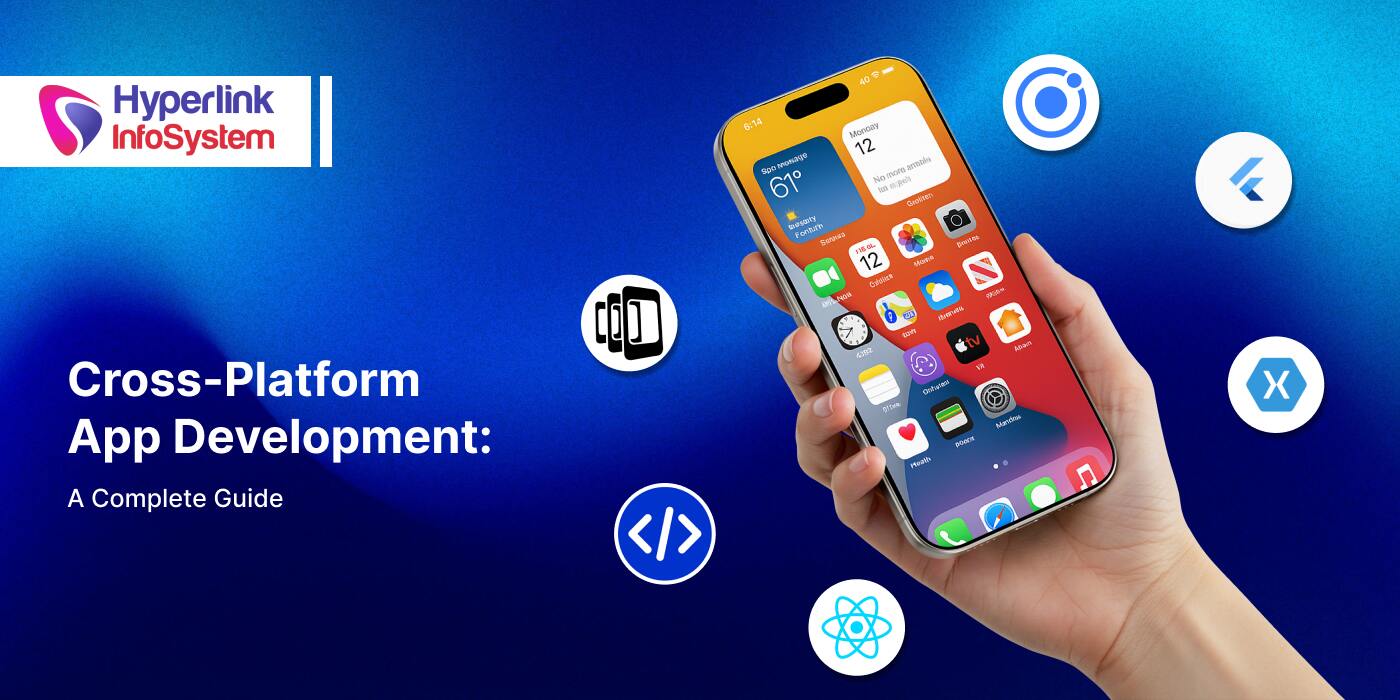Cross-Platform App Development in 2025: A Complete Guide
Aug 2025

Apps are an integral part of our lives in 2025. Be it online shopping, ordering food online, tracking calories, or buying plane tickets, everything is available on mobile apps. As per a survey, there are over 2.61 billion apps on the Google Play Store and 2.29 billion on the iOS Store.
It's pretty obvious that mobile app development is shaking things up for businesses; otherwise, we wouldn't be seeing so many apps flooding the market.
Some companies have the luxury of honing in on a specific niche, while others depend on app downloads, user engagement, and in-app purchases just to stay afloat. So, is cross-platform development the best bet for startups and businesses with tight budgets? Not always.
Even big-name companies and established brands are tapping into cross-platform apps for better efficiency, a unified codebase, and smarter cost management.
However, companies must realize that cross-platform development isn't a guaranteed ticket to success. They need to have solid strategies in place to enhance app store visibility, keep customers coming back, and ensure top-notch performance, but that's a discussion for another day.
In this blog, we’ll dive into various aspects of cross-platform app development, including its pros and cons, costs, the best languages and frameworks, the latest trends, and much more. Let’s get into the nitty-gritty!
What Is Cross-Platform App Development?
With cross-platform app development, developers can create mobile apps that function on both iOS and Android devices from just one codebase. Crafting separate code for each platform can consume a lot of time and money for businesses. Thanks to cross-platform development, developers only need to write the code once, and the app will perform smoothly on various devices.
Total revenue from cross-platform app development is projected to increase at a CAGR of 7.48% and reach a staggering US$781.70 billion by 2029. Cross-platform app development is the key to faster product time to market and long-term scalability.
Why Should Companies Choose Cross-Platform Development in 2025?
We completely understand that cross-platform development is a clever way for companies to cut down on time, money, and effort. Rather than reiterating the obvious, let’s take a look at some additional reasons why businesses are embracing cross-platform development in 2025.
Unified AI/ML Experience Across Diverse Devices
Creating cross-platform apps enables companies to provide smooth, intuitive, and user-friendly experiences across various devices. They achieve this by using shared AI models and real-time context.
Omnichannel Readiness
Come 2025, apps must run effortlessly on all sorts of devices. Think tablets, smartphones, laptops, dashboards, and more. Cross-platform frameworks are the solution.
Fast & Time Feature Releases
Companies can release simultaneous updates and ensure uniform UX across platforms, owing to a unified codebase. This ensures agile operations.
Device Diversity Support
Customers in emerging markets are tapping into a diverse array of devices with varying screen sizes, resulting in a fragmented landscape. Cross-platform development ensures that the same code runs seamlessly across all devices.
Centralized Security & Compliance
As developers handle only one codebase, it's easier for them to update, fix security issues, and perform patching across multiple platforms.
Developer Efficiency
Cross-platform development enables faster onboarding and building smaller teams with greater efficiency. This ensures they can do more by reusing the same code and existing skills.
Smarter Tooling & DevOps
Cross-platform frameworks work hand in hand with AI code assistance, analytics tools, and CI/CD pipelines. This combination enables quicker and smarter development while leveraging a data-driven approach.
Pros of Cross-Platform App Development
- Code Reusability - Developers can write code just once and run it across various platforms. This not only saves a ton of time but also makes life a lot easier.
- Faster Development - With a single codebase that works on both Android and iOS, development becomes more efficient, leading to quicker app launches and smoother maintenance.
- Cost-Effective - Unlike traditional development, which often requires separate teams for Android and iOS, cross-platform app development eliminates that need, saving both time and money.
- Wider Reach - Cross-platform development opens the door to a broader audience by allowing apps to be available on Android, iOS, and more. This means more users can download and enjoy the app.
- Simplified Maintenance - Forget the headaches of fixing bugs or adding features across different app versions. Cross-platform development streamlines maintenance, making it a breeze for companies.
- Uniform UI/UX - Cross-platform apps ensure that the user interface and experience remain consistent, no matter the platform. This uniformity creates a seamless and enjoyable experience for users.
- Quicker Prototyping - Developers can quickly create basic apps using cross-platform tools and get them out the door. This approach allows for gathering user feedback and refining their products.
- Vast Ecosystem - Frameworks like Flutter and React Native come with a robust toolkit, a variety of pre-built components, and a vibrant community. Regular updates and native code integration help speed up development and reduce errors.
Cons of Cross-Platform App Development
- Performance Limitations - When it comes to speed and responsiveness, native apps have the upper hand over cross-platform apps.
- Limited Native Features - There's a good chance that cross-platform apps won't fully support APIs or hardware that's specific to certain devices. As a result, developers might find themselves writing more native code for each platform they’re targeting.
- UI/UX Constraints - The design language and user experience can differ quite a bit from one platform to another. With cross-platform apps, a shared design might not always deliver the best performance or meet what users expect.
- Delayed OS/Update Support - Unlike native apps, users might miss out on the latest features when it comes to cross-platform apps.
- Debugging Complexities - Creating cross-platform apps means developers have to work with a common codebase. If a bug pops up, it might only show up on one platform, and the debugging tools for cross-platform apps aren’t as effective as those for native apps.
- Larger App Size - Typically, cross-platform apps incorporate additional abstraction layers to function across multiple platforms. This can lead to a larger app size compared to native apps.
- Heavily Dependent on Frameworks - When developers rely on external frameworks to create cross-platform apps, it opens up a lot of possibilities. However, if the app becomes outdated, stops receiving updates, or loses support, it can create significant issues for users.
- Limited Customization - Cross-platform apps are fantastic, but when it comes to building complex applications with advanced features and intricate interactions, the framework might not offer the best support. This could mean developers have to revert to writing native code for each platform.
Top 7 Frameworks for Cross-Platform App Development in 2025
1) Flutter
Language Used - Flutter
Ideal For - Mobile, web, and desktop apps
Key Features of Flutter
- Developers can take advantage of a single codebase that works across all platforms, including Windows, iOS, and Linux.
- Provides a wide range of custom widgets, visually appealing and well-designed UI components.
- Enjoys a great reputation for fast rendering, owing to the Skia graphics engine.
- Powered by Google, along with an ever-growing developer community.
2) React Native
Language Used - JavaScript and TypeScript
Ideal For - Mobile app development on iOS and Android
Key Features of React Native
- Provides native components that deliver high performance.
- Reuses code between different platforms while sharing logic with web apps through React.
- Offers access to mature libraries plus ensures support from a massive community.
- This is perfect for teams that are well-versed in JavaScript and React.
3) .NET MAUI
Language Used - C#
Ideal For - Desktop and mobile app development (Windows/macOS)
Key Features of .NET MAUI
- Enables native UI building with shared C# code.
- Ensures deep integration with Microsoft tools such as Visual Studio.
- Appropriate for enterprise-grade applications.
- Successor to Xamarin.Forms with a unified project structure.
4) Tauri
Language Used - Rust (Core) and JavaScript/TypeScript, plus HTML/CSS for front-end.
Ideal For - Perfect for developing lightweight desktop applications.
Key Features of Tauri
- Generates apps with smaller final executable files.
- Takes advantage of the OS’s native rendering engine instead of Chromium’s custom version.
- Places great emphasis on the app’s security and performance.
- Perfect for developing cross-platform yet lightweight apps.
5) Capacitor (By Ionic)
Language Used - JavaScript/TypeScript
Ideal For - Good for building web apps, offering access to native features (hybrid apps).
Key Features of Capacitor (By Ionic)
- Allows developers to create apps using standard web technologies such as HTML, CSS, and JavaScript.
- Enables web-based code to tap into device-specific features that are typically reserved for native apps, thanks to the use of plugins.
- Works effortlessly with popular front-end frameworks such as React, Angular, and Vue.
- Best for teams that have worked on web development projects before.
6) Kotlin Multiplatform
Language Used - Kotlin
Ideal For - Perfect for sharing business logic across multiple platforms like Android, iOS, web, and desktop.
Key Features of Kotlin Multiplatform
- Developers can write the core logic just once in Kotlin and reuse it across multiple platforms.
- Works seamlessly with existing Android codebases, so there is no need to write code from scratch.
- Kotlin’s libraries, tools, and features are ever-evolving, making it a fantastic choice for iOS app development.
- Strong backing by JetBrains, which has created Kotlin and IntelliJ.
7) Unity
Language Used - C#
Ideal For - Best for game development and immersive apps (AR/VR)
Key Features of Unity
- Real-time 3D and 3D rendering engine.
- Supports export to more than 20 platforms, including mobile, desktop, consoles, and VR.
- Get access to a strong ecosystem of game assets and plugins.
- Unity is a popular choice in gaming, simulation, and XR industries.
Top Programming Languages for Cross-Platform App Development in 2025
Below are the top programming languages for cross-platform app development in 2025.
1) Dart
- Designed for Flutter, excellent for expressive and high-performance UIs.
- Compiles fast and supports hot reload for rapid development.
2) JavaScript/TypeScript
- Powers popular frameworks such as React Native, Capacitor, and Tauri.
- Boasts an enormous ecosystem of hundreds of libraries and strong community support.
3) C#
- Core language for .NET MAUI and Unity.
- Backed by Microsoft, plus robust IDE support and enterprise dependability.
4) Kotlin
- Allows developers to reuse code across multiple platforms, including Android, iOS, desktop, and web.
- Apps developed using Kotlin feel and behave like iOS apps. It also enables developers to build native UIs for each platform.
5) Rust
- Usually used in Tauri for developing super-light, secure, and high-performance applications.
- Excellent memory safety and performance, great for low-level logic
6) C++
- The foundation of several powerful game engines, like Unreal, and high-performance apps.
- Ideal choice when speed, control, and native-level access are the topmost priority.
When to Use and When Not to Use Cross-Platform App Development
As I pointed out earlier, cross-platform app development is a smart path for businesses aiming to reduce expenses, speed up product launches, and attract a broader audience. Still, there are cases where this method might not be suitable. Below, I’ve listed some situations that can guide you on when to embrace it and when to hold back.
When Cross-Platform Development is the Best Choice
- Budget and Time Constraints - This approach is perfect for startups or anyone looking to launch a minimum viable product. It enables faster development and cuts down on maintenance costs, all thanks to a single codebase.
- Same App Logic Across Platforms - If your app doesn’t need platform-specific UI or features, this is the way to go. Many companies opt for cross-platform app development for content-driven apps, dashboards, CRM systems, or social media platforms.
- Wider Audience - If your goal is to reach as many users as possible, cross-platform apps are a smart choice since they can be launched on both iOS and Android at the same time. When time is tight and you need to get your project out the door quickly, cross-platform development is the way to go.
- Popular Cross-Platform Networks - For businesses using frameworks like Flutter, React Native, or Kotlin Multiplatform, cross-platform development is a fantastic option. These frameworks provide high performance, a near-native user interface, and allow access to native APIs through plugins or bridging.
- Web-First Teams - Companies with in-house JavaScript or Dart developers should think about cross-platform app development. This way, there’s no need to hire iOS specialists or Android specialists.
- For Internal Tools or Enterprise Purposes - When creating an app for internal company use, UI/UX standards often take a backseat. Developers can focus on rolling out products quickly and efficiently, using fewer resources.
When Cross-Platform App Development is Not the Best Choice
- High-Performance Apps - When it comes to building high-performance or hardware-intensive apps, think real-time video or audio processing, 3D graphics, or AR/VR, along with low-latency animations or high frame rates, cross-platform app development just doesn’t cut it. That’s where Switt for Kotlin shines, giving you complete control over your app’s performance.
- Platform-Specific UI/UX Components - Now, let’s talk about platform-specific UI/UX components. iOS and Android are distinct platforms, each with its own user habits and design guidelines. An app might look the same on both, but it could miss out on key features or lag during animations. This can frustrate users, leading to uninstalls or negative reviews.
- Constant Access to Native SDKs and Low-Level APIs - When it comes to apps that need constant access to device features like Bluetooth, the camera, or sensors, cross-platform development might not be the best route. Cross-platform plugins often lag behind native SDKs in updates, meaning new features might not make it into your app right away. This can lead to extra work for companies trying to customize their apps.
- Scaling With Extensive Features - Scaling complex apps can also be tricky due to codebase abstraction and plugin dependencies. Developers might find themselves writing more bridging code to make up for the limitations of cross-platform tools, which can drive up maintenance costs, slow down performance, and increase the time spent on fixing bugs.
- Deep Integration With OS Features - To truly tap into unique OS features, developers often have to write platform-specific code. Think iOS-only widgets or shortcuts and Android-specific intents and custom launchers. In these cases, going for native development is usually the way to go, as it allows for smoother and more timely integration.
- Advanced Security Needs - Finally, industries like healthcare, finance, or government have to adhere to strict security measures and regulations. This makes it crucial to choose the right development approach to ensure compliance and protect sensitive data.
Cost of Cross-Platform Development
Cross-platform development may be a good choice for your business, but it is crucial to understand the costs involved before taking the plunge. Below are the costs associated with cross-platform development.
App complexity matters because it can greatly affect development costs.
|
Cost Component |
Estimated Cost (USD) |
Notes |
|
Planning and Research |
$1,000 – $5,000 |
Market research, feature planning, and competitor analysis |
|
UI/UX Design |
$2,000 – $10,000 |
Wireframes, responsive design for multiple devices |
|
Cross-Platform Development |
$10,000 – $60,000+ |
Using Flutter, React Native, Kotlin Multiplatform, and others. |
|
Backend Development |
$5,000 – $25,000 |
API Integration, databases, and admin panel |
|
Third-Party Services |
$500 – $5,000 per year |
Maps, chat, analytics, payment gateways (SDKs/APIs) |
|
Q&A Testing |
$2,000 – $8,000 |
Device testing, bug fixing, and performance optimization |
|
App-Store Development |
$100 - $300 |
Google Play ($25 one-time), Apple Store ($99/year) |
|
Maintenance and Updates |
$2,000 – $15,000 |
Bug Fixes, OS updates, and feature enhancements |
|
Project Management |
$1,000 – $5,000 |
Time tracking, communication, and coordination |
|
Marketing and Launch |
$1,000 – $20,000+ |
App store optimization, social media, ads, and PR |
Cost By Framework
Below is the cost breakdown as per the framework.
|
Framework |
Development Speed |
Community Support |
Typical Costs (USD) |
|
Flutter |
Fast |
Strong |
$20,000 – $100,000 |
|
React Native |
Fast |
Strong |
$20,000 – $120,000 |
|
Kotlin Multiplatform |
Moderate |
Growing |
$30,000 – $130,000 |
|
Xamarin |
Slower |
Moderate |
$25,000 – $110,000 |
Note that these costs are just to give you a brief idea of how much money you may have to set aside for cross-platform app development. For an accurate estimate, it is best to consult a professional cross-platform app development company.
10 Future Trends for Cross-Platform App Development
Below are some of the most emerging trends for cross-platform app development.
- AI Integration – Smarter apps with in-built AI features such as chat, vision, and predictions.
- Flutter 3+ Dominance – Growing adoption due to native-like performance and rapid UI development.
- React Native Modernization – TurboModules and Fabric enhancing speed and flexibility.
- WebAssembly Support – Better performance for web and hybrid apps across multiple platforms.
- Kotlin Multiplatform Rise – Shared logic for Android, iOS, and desktop from one Kotlin codebase.
- Low-code/no-code Platforms – Democratizing app creation with visual tools and automation.
- Cloud Integration-First Approach – Seamless access to backend services like Firebase or AWS.
- Progressive Web Apps (PWAs) – Browser-based apps are gaining power and offline capabilities.
- Enhanced DevOps & CI/CD tools – Faster builds, testing, and updates across platforms.
- Adaptive UI Frameworks – Responsive designs that adapt to foldables, wearables, and desktops.
Ending Thoughts
Cross-platform app development may seem like a shortcut to many individuals. Writing a single code for all platforms, speedier development, quicker product to market, and lower costs are the benefits, but companies must also consider the cons of cross-platform development. Compared to native apps, cross-platform apps usually don’t match the level of performance in terms of speed, memory usage, and animation smoothness.
The solution lies in adopting a hybrid approach where one leverages cross-platform development for basic features and writes custom code only when required. Developers must use mature frameworks like Flutter and React Native. While Flutter is great for high-performance UIs, React Native allows developers to write a large chunk of the code in JavaScript or TypeScript. Not only does this enable the reuse of 90 to 95 percent of the code, but it also speeds up development while cutting costs. Rigorous testing is also a must.
Does this sound like too much work for you? No worries, Hyperlink InfoSystem is a reputed cross-platform app development service provider with 12+ years of industry experience. With hard work, determination, and perseverance, we have accomplished over 5000+ projects in the last decade. Our clientele, consisting of 2000+ companies, can vouch for our efficiency and professionalism. Speak with one of our experts to see what we can do for you.
Schedule a Consultation Today!
Frequently Asked Questions
The most popular cross-platform app development frameworks in 2025 are as follows-
- Flutter - Enjoys an excellent reputation for its performance and UI flexibility.
- React Native (JavaScript) - Known for its strong ecosystem and community.
- Kotlin Multiplatform - Rising in popularity due to its shared business logic across platforms.
- .NET MAUI (C#) - Perfect for enterprise apps with Microsoft stack integration.
For complex games and high-performance applications, companies typically opt for game engines such as Unity or Unreal. On the flip side, if a company wants to develop business and social apps or content-focused solutions, cross-platform frameworks are the way to go. In such apps, real-time graphics are a secondary concern.
Hiring dedicated app developers in India means you get access to experienced and talented developers who can work in shifts. This speeds up development, while you don’t have to shell out thousands of dollars. In contrast, hiring app developers in the USA or Europe yields good results, but it can be super expensive. App development companies in the USA and Europe can charge anywhere between $100 $150 per hour. The main objective of cross-platform app development is to reduce costs and get more value for money.
Companies on a budget must consider hiring dedicated app developers in India, while those who have plenty of money at their disposal can choose American/European companies.
Creating apps for each platform separately is what native development is all about. For instance, Swift is the go-to language for iPhones, while Kotlin or Java is used for Android devices. This method allows companies to craft apps that perform seamlessly on their respective platforms, ensuring users have a smooth experience. They can enjoy all the app's features without any hassle.
On the flip side, cross-platform app development offers a more straightforward and budget-friendly alternative. Companies don’t have to build different apps for each platform; they just need to write code that works on both iPhone and Android. While this approach saves time and money, users might find themselves sacrificing some of the app’s aesthetics and performance for the sake of convenience.
For sure, it's possible to bring in third-party services with cross-platform apps! A lot of these services, such as analytics, payment gateways, and social login, offer SDKs or APIs that integrate smoothly with cross-platform frameworks.
Latest Blogs

Is BlockChain Technology Worth The H ...
Unfolds The Revolutionary & Versatility Of Blockchain Technology ...


IoT Technology - A Future In Making ...
Everything You Need To Know About IoT Technology ...

Feel Free to Contact Us!
We would be happy to hear from you, please fill in the form below or mail us your requirements on info@hyperlinkinfosystem.com
Hyperlink InfoSystem Bring Transformation For Global Businesses
Starting from listening to your business problems to delivering accurate solutions; we make sure to follow industry-specific standards and combine them with our technical knowledge, development expertise, and extensive research.
4500+
Apps Developed
1200+
Developers
2200+
Websites Designed
140+
Games Developed
120+
AI & IoT Solutions
2700+
Happy Clients
120+
Salesforce Solutions

40+
Data Science

















